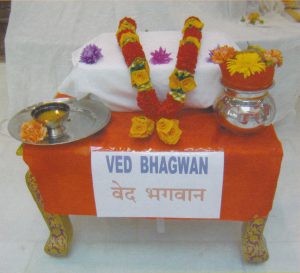“Vedaishcha Sarvair Aham Eva Vaidya, Vedaanta Krid Veda Vid Eva Chaaham.”
I am verily present throughout the Vedas. I am the author of Vedanta, and I am the knower of the Veda. (B.G. 15th)
The world’s oldest religious scriptures are universally recognized to be the Vedas of Satya Sanatan Dharma. They are as old as time. They personify the various energies and vibrations that have made, keep in order and will destroy the universe. Vedas literally means knowledge. They contain immortal knowledge which is God Himself.
The Veda existed subtly in the universe. The Veda is truth personified and it is upon the basis of these truths that the universe was created; therefore the Veda is embedded in each atom of creation. To understand the Veda is to understand God. The devoted Rishi and Munis (Saints and Sages), due to their intellectual and spiritual prowess enabled the Veda to be ‘heard’ by them. Upon meditation of their meanings, the sages discovered ’Shabda Brahman’ – God in the form of sound. The saints and sages gathered all the mantras of the Veda into a vast compilation and through the understanding of these mantras the Hindus achieved the four goals of life.
Throughout the first three ages, the Veda was memories and taught from Guru to disciple.It was, as it was in the beginning ‘heard’. this gave rise to the name ’Shruti’ – that which is heard.
The Shruti is the main scriptural authority upon which the whole universe is based, whether it is accepted or not, it is a fact.
Near the beginning of this age, the saints realised that the human mind was becoming weak and mental power was diminishing. In order to categorise and write down the Veda, Bhagavan Vishnu incarnated as Shri Veda Vyas Ji. He split the Veda into four vedas.
The Rig Veda dealt with understanding the Lord.
Yajur Veda dealt with the mantras required in sacrificial worship.
the Saam Veda contains the hymns and music required to complete the worship and the Atharva Veda deals with the properties of various elements of creation. He then split them further into their categories whether it was to deal with ritual, knowledge, language, art, wealth, astrology, meter etc.
The Upanishads are the most famous part of the Vedas, containing the immortal knowledge of God.
The age of the Veda dates back to the beginning of time. There is a verse in the Rig Veda that cites a solar eclipse 32,000 years ago. Therefore we must conclude that it was written towards the end of the last age. We should be humbly proud that our religion has the oldest PROVEN roots in the world. Unfortunately today what remains of the Veda is very little – less than ten percent
of the original body; the remainder being centered on ritual alone. But it must be remembered that whatever we still have is the origin of everything, and the foundation of our way of life and need preservation. We should endeavour to study Sanskrit, the language of the Veda and its commentaries, and we should protect Vedas, as ‘Vedo’khilo dharma moolam’ – the veda is the origin of all religions. Being that the Veda is the origin of Hinduism we must remember that ‘Dharmo raskhati rakshitah’ Religion protects when it is protected. We should protect the eternal way of life by protecting and encouraging the propagation of its roots.
One is entitled to study the Vedas after taking initiation from a Guru, taking the sacred thread and learning Sanskrit. Hindus should endeavor that at least one son from every family is thus educated, thus ensuring the progress of the ideas of the true way of life.


